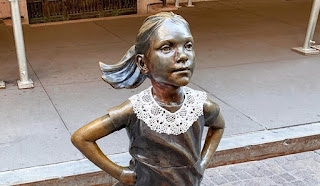Finding Fearless
Who owns art? Who owns the space of art? And who dictates the meaning to be found within the space that art inhabits?
I've asked these questions before - indeed, much of my previous research was tangled up with questions of art and ownership, and many others, much more learned than myself, have argued these points throughout history. But this is my little corner of the internet, so this is my little, incoherent ramble.
 |
| Image Source: secretnyc.co |
The statuette, who has, since her initial installation and controversy, been relocated to stand opposite the New York Stock Exchange - has been fitted with a jabot collar, in honour of the recognisable garment often worn by Bader Ginsburg.
The Jabot Collar itself is interesting: RBG apparently referred to this extremely feminine, lace garment as her "dissent collar" (1) as she aimed to "unapologetically feminize" the male-dominated world inside the Supreme Court of America. However, the jabot collar as an item of clothing is, while descended from the decorative ruffles of clothing styles in the sixteenth and seventeenth centuries, still seen as part of the official court dress of judges and justices around the world. This 'unapologetic feminisation' is a specifically feminine appropriation of a male garment designed to imply status and superiority.
 |
| Image Source: news18.com |
But I digress. So...
The initial furore over the installation of Fearless Girl in 2017 led me to ask questions of the perception of art and who owns it. Fearless Girl is a corporate entity, for all that she was perceived to be standing in opposition to this entity. Is she still the little girl facing down the bull of capitalist America, or has Arturo DiModica (the creator of the Charging Bull) reasserted his original intention for his guerilla artwork; the bull is the American people charging the banks, reminding those who work on Wall Street to whom they are beholden. Fearless Girl (who was commissioned by one of the firms on Wall Street) changed this meaning - the Bull became the banks, the stockbrokers, and the Girl became the symbol of resistance. Does her removal away from her confrontation away from the Bull confirm the original intent of DiModica's work, or does it imply that, in the Bulls new incarnation, the people are standing aside to let capitalism run rampant?
By now giving her the signifiers associated with Bader Ginsburg, Fearless Girl has metamorphosed once more - she is now a little girl who could grow up to be on the Supreme Court; she is a little girl, telling other little girls (whether grown or not) that they can be whoever they want to be if they work hard, as RBG undoubtedly did.
Fearless little Girl is growing up in a new world, and her identity changes as the world around her changes. And the world sees in her the things that they want to see.
(1) https://www.thedrum.com/news/2020/09/22/wall-street-s-fearless-girl-dons-lace-collar-tribute-ruth-bader-ginsburg



Comments
Post a Comment